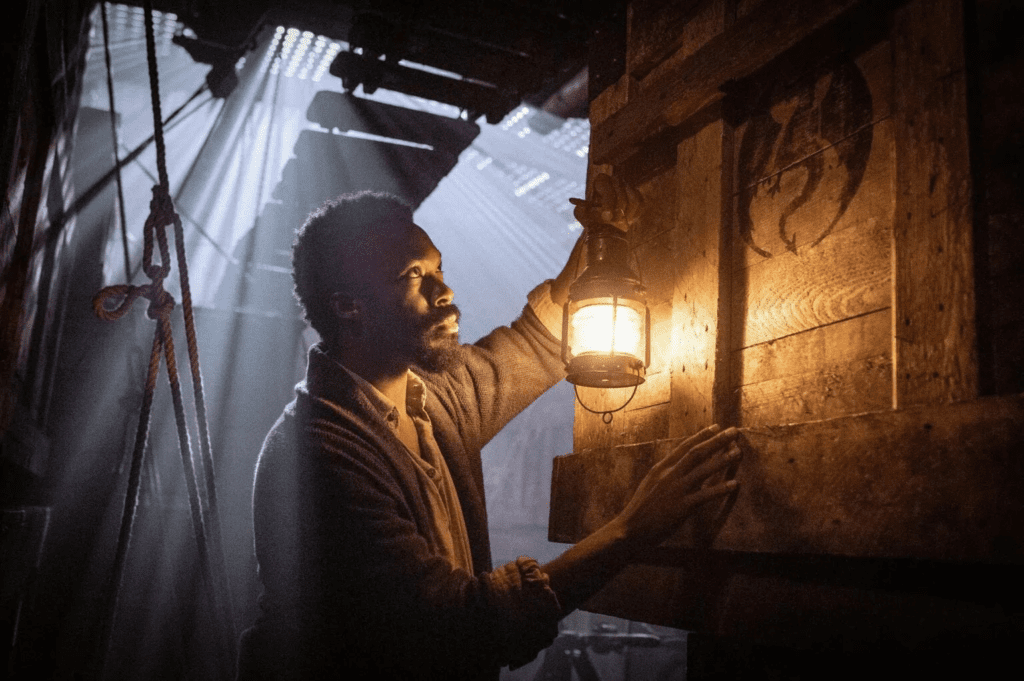DRACULA: THE VOYAGE OF THE DEMETER Reviewed by GREG KING
Director: Andre Ovredal
Stars: Liam Cunningham, Corey Hawkins, David Dastmalchian, Woody Norman, Aisling Franciosi, Javier Botet.
Alien at sea?

Dracula is the most portrayed character in film and there have been over 300 films featuring the famous character created by Bram Stoker in his classic 1897 novel. The Voyage Of The Demeter is yet another film that adds to the legacy of the notorious character.
The time is 1893. The Demeter, a Russian cargo ship, sets sail from Carpathia, bound for London carrying some 50 large, unmarked crates embossed with a dragon logo. There is an early portent of something wrong when many of the workers loading the crates onto the ship are panicked by the sight of the logo and leave the wharves.
In charge of the ship is Captain Elliot (Liam Cunningham, from Game Of Thrones, etc), who has been promised a large bonus upon the timely completion of the journey. He announces that this will be his last voyage, and announces that his chief mate Wojchek (David Dastmalchian, from Late Night With The Devil, etc) will be the new captain. Wojchek is a Polish orphan who has spent most of his life at sea. Also on board are Toby (Woody Norman, from C’mon, C’mon), the captain’s grandson who has a healthy curiosity, and Clemens (Corey Hawkins, from Straight Outta Compton, etc), a Cambridge educated doctor who is viewed with suspicion because of the colour of his skin.
But midway through the voyage, the crew find Anna (Aisling Franciosi, from The Nightingale, etc), a Transylvanian woman who was being transported in one of the crates. She is very sick, and Clemens nurses her back to health with blood transfusions. Then something sinister begins attacking the crew at night and slaughtering the livestock. Anna tells the crew of the very real horror they are dealing with in the person of Dracula. Clemens values science over superstition, and he works with Anna to make sense of the strange events and brutal deaths that have occurred.
The film opens with the beaching of the Demeter on a storm-wracked coast of England. When the local authorities arrive at the wreck, they find the ship abandoned with no sign of life aboard. A search reveals only the captain’s diary in which he had kept a record of the strange events that plagued the last voyage of the ship. Then we flashback to the voyage itself.
Written by Bragi F Schut (Escape Room, etc) and Zak Olkewicz (Bullet Train, etc) The Voyage Of The Demeter is based on a subplot from one chapter of Bram Stoker’s classic 1897 novel, and it expands on the events briefly described in The Captain’s Log, in which the captain wrote about the strange nocturnal deaths of the doomed crew. Dracula: The Voyage Of The Demeter is an effective horror film as Norwegian director Andre Ovredal (Trollhunter, etc) imbues the material with a strong sense of unease and menace with a couple of taut and well-staged set pieces. He creates an unsettling atmosphere through the gloomy lighting, which creates an oppressive mood that heightens the claustrophobic tension, the thick rolling fog that shrouds the production, and the haunting soundscape of the crashing waves and the creaking timbers. And the score from Bear McCreary is also quite ominous and unsettling.
Cinematographers Roman Osin (Pride And Prejudice, etc) and Tom Stern (a frequent collaborator of Clint Eastwood) use a bleak and greyish colour pallet to good effect in creating a Gothic tone for the material. Some of the deaths are quite brutal and visceral. The film also boasts some impressive production design from Edward Thomas to create the interior of the Demeter, which was largely filmed in Germany’s Studio Babelsberg.
Performances are solid, with Hawkins bringing a sense of decency and gravitas to his role as Clemens, while Cunningham is good as the grizzled veteran sea captain. Dastmalchian brings his usual twitchy, nervous energy to his role.
The character of the vampire Dracula, or Nosferatu, is seen in fleeting glimpses early on as a shadowy figure hiding in darkened corners or crawling throughout the ship, which heightens the suspense until we see the creature in full grotesque profile. As played by Spanish actor Javier Botet (who has carved out a career playing sinister figures in horror films like 2018’s Slenderman, etc) he resembles the more famous and iconic image of Count Orlok from the 1922 silent film Nosferatu from German filmmaker F W Murnau rather than the more urbane version of the character played by Christopher Lee in the series of films from the Hammer studios or even George Hamilton, and he is certainly more creepy and sinister looking than Gary Oldman in Coppola’s stylish 1992 adaptation of Stoker’s novel.
Dracula, The Voyage Of The Demeter is an effective and well shot horror film that provides yet another intriguing take on the familiar tale of the most famous fictional vampire in film and literature.
★★★☆



